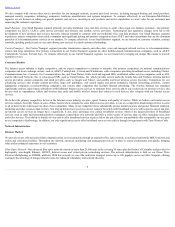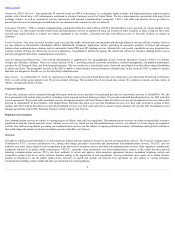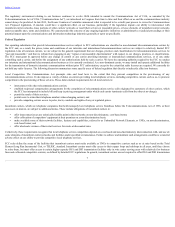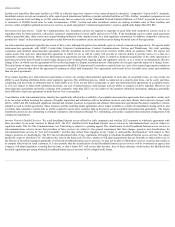Earthlink 2015 Annual Report Download - page 18
Download and view the complete annual report
Please find page 18 of the 2015 Earthlink annual report below. You can navigate through the pages in the report by either clicking on the pages listed below, or by using the keyword search tool below to find specific information within the annual report.
Table of Contents
ineffective or unacceptably costly, we may not be able to compete effectively. In addition, new technologies may be protected by patents or other intellectual
property laws, and, therefore, may be available only to our competitors. Any of these items could adversely affect our business, results of operations and cash
flows.
Failure to achieve operating efficiencies and otherwise reduce costs would adversely affect our results of operations and cash flows.
In light of declining revenues, we have been focused on optimizing our cost structure and maximizing our cash flows. This includes reducing cost of revenues,
streamlining our internal processes and right sizing our workforce to current revenue trends. It also includes the repayment and/or refinancing of indebtedness in
order to reduce our interest expense. The success of our operating efficiency and cost reduction initiatives is necessary to align costs with declining revenues for
traditional voice and data products and to combat pressure non-variable costs place on margins. We have incurred and may continue to incur upfront costs to
achieve these efficiency and cost reduction initiatives. In addition, although we have been successful in our efforts to reduce costs over the past few years, we may
not be able to continue to achieve this level of cost savings and there will be decreasing opportunities for cost savings in the future. Additionally, we may not be
able to continue to repay indebtedness and thereby reduce our interest expense. If we do not recognize the anticipated benefits of our operating efficiency and cost
reduction opportunities in a timely manner or they present greater than anticipated costs, our results of operations and cash flows would be adversely affected.
We may have to undertake further restructuring plans that would require additional charges.
During 2015, we incurred restructuring charges as a result of changes to our business strategy and operating structure. We plan to continue to evaluate our business,
which may result in additional restructuring activities. We may choose to consolidate or close certain facilities, implement workforce reductions or outsource
certain functions. Decisions to engage in future restructuring activities could involve the expenditure of capital, consumption of management resources, realization
of losses, transition and wind-up expenses, workforce reductions, impairment of assets and the elimination of revenues along with associated costs, any of which
could adversely affect our results of operations and cash flows and may fail to yield the expected benefits.
We may be unable to successfully divest non-strategic products, which could adversely affect our results of operations.
From time to time we consider the divestiture of non-strategic products, assets and customers based on management's assessment of their strategic value to our
business. Divesting certain of our products or assets would be complex operationally due to their interrelationships with assets and products we would desire to
retain. Any divestiture also would need to be transacted in accordance with the terms of our debt agreements. Additionally, decisions to divest certain business
operations could involve the expenditure of capital, consumption of management resources, realization of losses, transition and wind-up expenses, workforce
reductions, impairment of assets and the elimination of revenues along with associated costs, any of which could adversely affect our results of operations and cash
flows and may fail to yield the expected benefits.
Acquisitions we complete could result in operating difficulties, dilution, increased liabilities, diversion of management attention and other adverse
consequences, which could adversely affect our results of operations.
We may continue to evaluate and consider potential strategic transactions in order to grow our business. At any given time, we may be engaged in discussions or
negotiations with respect to one or more of such transactions that may be material to our financial condition and results of operations. There can be no assurance
that any such discussions or negotiations will result in the consummation of any transaction, or that we will identify appropriate transactions on terms acceptable to
us. Adverse capital markets and volatility in our stock price could also negatively impact our ability to make acquisitions. Future acquisitions may result in
significant costs and expenses and charges to earnings, including those related to severance, employee benefit costs, retention costs for executive officers and key
employees, asset impairment charges, integration costs, charges from the elimination of duplicative facilities and contracts, unexpected liabilities, legal, accounting
and financial advisory fees.
Additionally, future acquisitions may result in the dilutive issuances of equity securities, use of our cash resources, incurrence of debt or contingent liabilities,
amortization expense related to acquired definite-lived intangible assets or the potential impairment of amounts capitalized as intangible assets, including goodwill.
Any of these items could adversely affect our business, results of operations and cash flows.
Our ability to achieve the benefits of acquisitions depends in part on the successful integration and leveraging of technology, operations, sales and marketing
channels and personnel. Integration and other risks associated with acquisitions can be more pronounced for larger and more complicated transactions or if multiple
transactions are integrated simultaneously. The challenges and risks involved in the integration of our acquired businesses, as well as any future businesses that we
may acquire, include:
15
























